Discrete Mathematics Lesson 19: Intro to Graph Theory
- Announcements
- Structure of this lesson
- Lesson 18 Exit Ticket
- Seven Bridges of Königsberg
- Definitions
- Some Quick Theorems
- Special Kinds of Graphs
- Further reading and exercises
Announcements
- Only one more problem set left (choice between problem set on equivalence relations or on graph theory).
- Final Exam.
- Groups / topics?
Structure of this lesson
Today’s lesson will be slightly different:
- In class, we will go over the questions that I would have asked on an exit ticket for lesson 18. This way we can work on these together and can work through some of the trickier definitions / ideas.
- On your own, you will go through the notes / videos on graph theory. We will continue with graph theory on Thursday!
Lesson 18 Exit Ticket
Instead of having you hand these in, we will just go over these in class today.
Questions:
- Define the relation $\sim$ on $\mathbb{R}$ as $x \sim y$ if both $x$ and $y$ are positive, or both $x$ and $y$ are negative, or both $x$ and $y$ are 0.
- Show that $\sim$ is an equivalence relation.
- What is the equivalence class [1]?
- What is the equivalence class [-1]?
- What is the equivalence class [0]?
- Show that all real numbers are in [-1], [0], or [1].
- For $x, y \in \mathbb{R}$, let $x \sim_2 y$ iff $\sin(x) = \sin(y)$.
- Show that $\sim_2$ is reflexive.
- Show that $\sim_2$ is symmetric.
- Show that $\sim_2$ is transitive.
- What is the equivalence class $[0]$? Is this set countable or uncountable?
- What is the equivalence class $[\pi/2]$?
- What is the equivalence class $[\pi/6]$?
- Show that for every real number $x$, there is a real number $y$ in the interval $[-\pi/2, \pi/2]$ such that $x \sim_2 y$. Hint: look at the graph of $f(x) = \sin(x)$ restricted to the interval $-\pi / 2 \leq x \leq \pi / 2$.
- Show that different real numbers $x \neq y$ in the interval $[-\pi/2, \pi/2]$ are in different equivalence classes. That is: if $x \neq y \in [-\pi/2, \pi/2]$, then $\sin(x) \neq \sin(y)$.
Notice: $\mathbb{R} / {\sim_2}$ can be represented as $[-\pi/2, \pi/2]$ by the last two parts. Further, notice that $f : \mathbb{R} / {\sim_2}$ defined by $f([x]) = \sin(x)$ is a one to one function! In fact there is more to see here: first you need to see that it is, in fact, a well defined function: if $[x] = [y]$, then $\sin(x) = \sin(y)$ by definition. Then you can see that it is one-to-one: if $[x] \neq [y]$, then $\sin(x) \neq \sin(y)$. All of this is pretty immediate from the definitions, but this points to how equivalence classes are often used: you can take a function defined on a large set, look at the “quotient” by the equivalence relation $x \sim y$ iff $f(x) = f(y)$, and then you end up with a one to one function with a new domain (the quotient set).
- Let $X = \mathbb{R}$ and consider the sets $U_n = [n, n+1)$ for each $n \in \mathbb{Z}$.
- Show that this collection of sets forms a partition of $\mathbb{R}$. Hint: to show that a collection of sets is a partition, you show two things: if $x \in \mathbb{R}$, then there is $n$ such that $x \in U_n$, and if $n \neq m \in \mathbb{Z}$, then $U_n \cap U_m = \emptyset$. Another hint: every real number has a decimal representation. Round the number down. * Can you find an equivalence relation that would give these classes? (Try to think of one but I’m not taking off points if you can’t.)
- How many classes are there in this partition? (Yes there are infinitely many. But how infinite? $\aleph_0$? Uncountably many?)
- How large is each class in this partition? (Yes each set $[n, n+1)$ is infinite. Is it possible that these are countable? Compare that with your answer to the previous part and the fact that the union of all of these is $\mathbb{R}$, which is uncountable.)
Please follow along the rest of the notes on your own by Thursday’s class!
Seven Bridges of Königsberg

Königsberg, Prussia (now known as Kaliningrad, Russia) is the setting for one of the most important problems in the development of modern mathematics. The city was laid out as pictured above, with seven bridges connecting several landmasses around the Pregel River. A tale is told about how the citizens of this city used to walk around the bridges and wonder how one might plan a walk around the city crossing each bridge exactly once.
In 1736, Leonhard Euler proved that this would be impossible! In his proof, he recognized some simplifying assumptions that led to the modern development of graph theory and topology. In particular, he recognized that the relative shapes of each region is not really important, but what is only important are the connections between each region (the number of bridges connecting different regions). Mathematicians now recognize this as a graph-theoretic problem: given a set of vertices and some edges between those points, is there a path one can take that crosses each edge exactly once?

Definitions
Mathematically, we formalize the notion of graphs (vertices and edges between them) using set theory. A graph is an ordered pair $(V, E)$, where $V$ is a set, denoting the vertices of the graph, and $E$ is a set of edges, consisting of pairs of vertices. There are a few ways to refer to edges:
- “Unordered pairs”, or sets of size 2
- Ordered pairs $(a, b)$.
I usually will use ordered pairs as it generalizes to several situations, but you may see either notation in different textbooks. Either way, for each $e \in E$, we associate one or two vertices, known as its endpoints. Two endpoints of an edge are adjacent: that is, two vertices $v$ and $u$ are called adjacent if there is an edge connecting $v$ and $u$.
A vertex is most often depicted as a point in space ($\mathbb{R}^2$ or $\mathbb{R}^3$), and an edge is depicted as a curve joining the endpoints.
A graph is called simple if it has no self-loops and there is at most one edge between any two pair of vertices. (Note: the “Königsberg” graph is not simple).
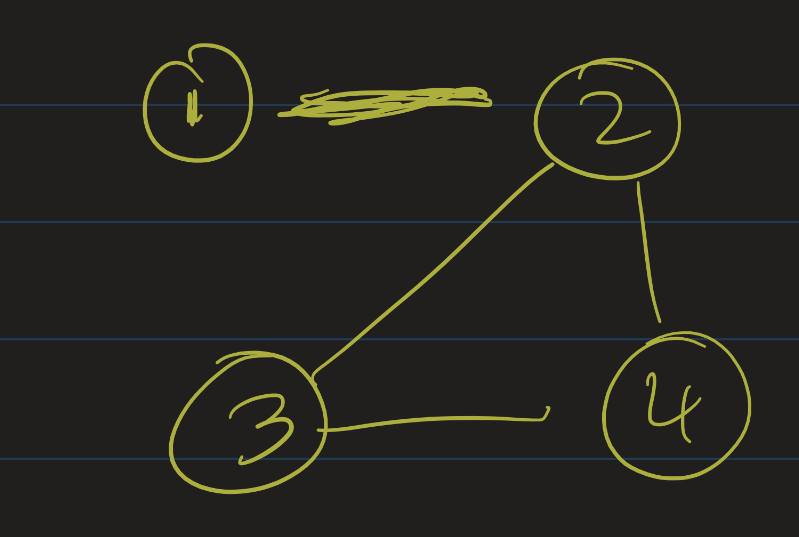
Graphs can be either directed or undirected.
- In a directed graph, each edge has a direction. This is usually formalized as each edge being an ordered pair $(a, b)$, where $a$ is the start vertex and $b$ is the terminal vertex.
- In an undirected graph, edges are bidirectional. That is, two vertices are either connected by an edge or they are not. As mentioned, this can be formalized using “unordered pairs” or ordered pairs. If we used ordered pairs to represent an undirected graph, we must insist that the edge relation is symmetric: that is, if $(a, b) \in E$, then $(b, a) \in E$.
Directed graph:
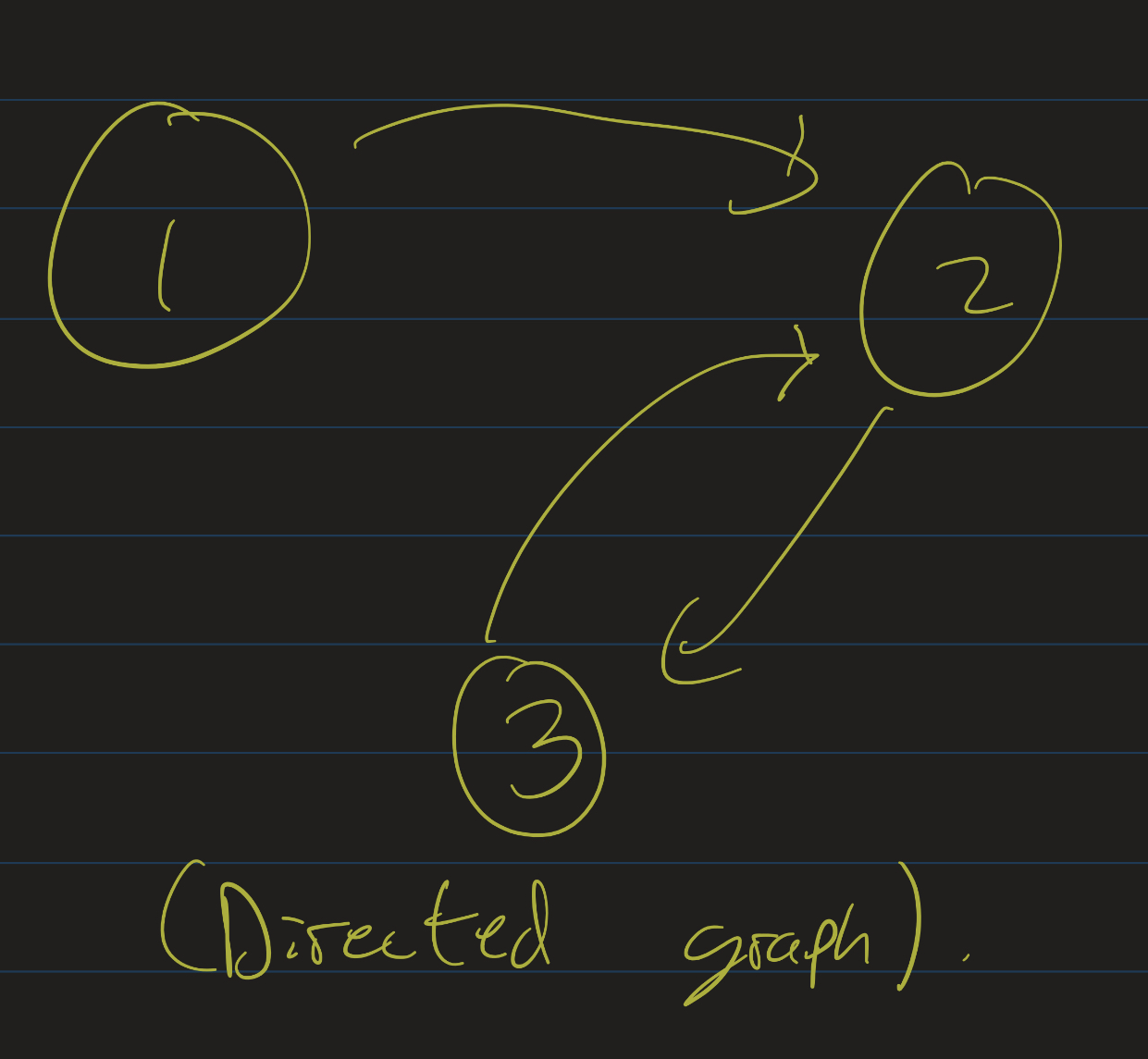
Undirected graph:

Graphs can be weighted and/or labeled. We can label vertices and/or edges, and we can weight vertices and/or edges. Often this is done for path-finding algorithms, where the vertices are labeled by locations, and edges are weighted by the time (or distance) it would take to travel between those locations.
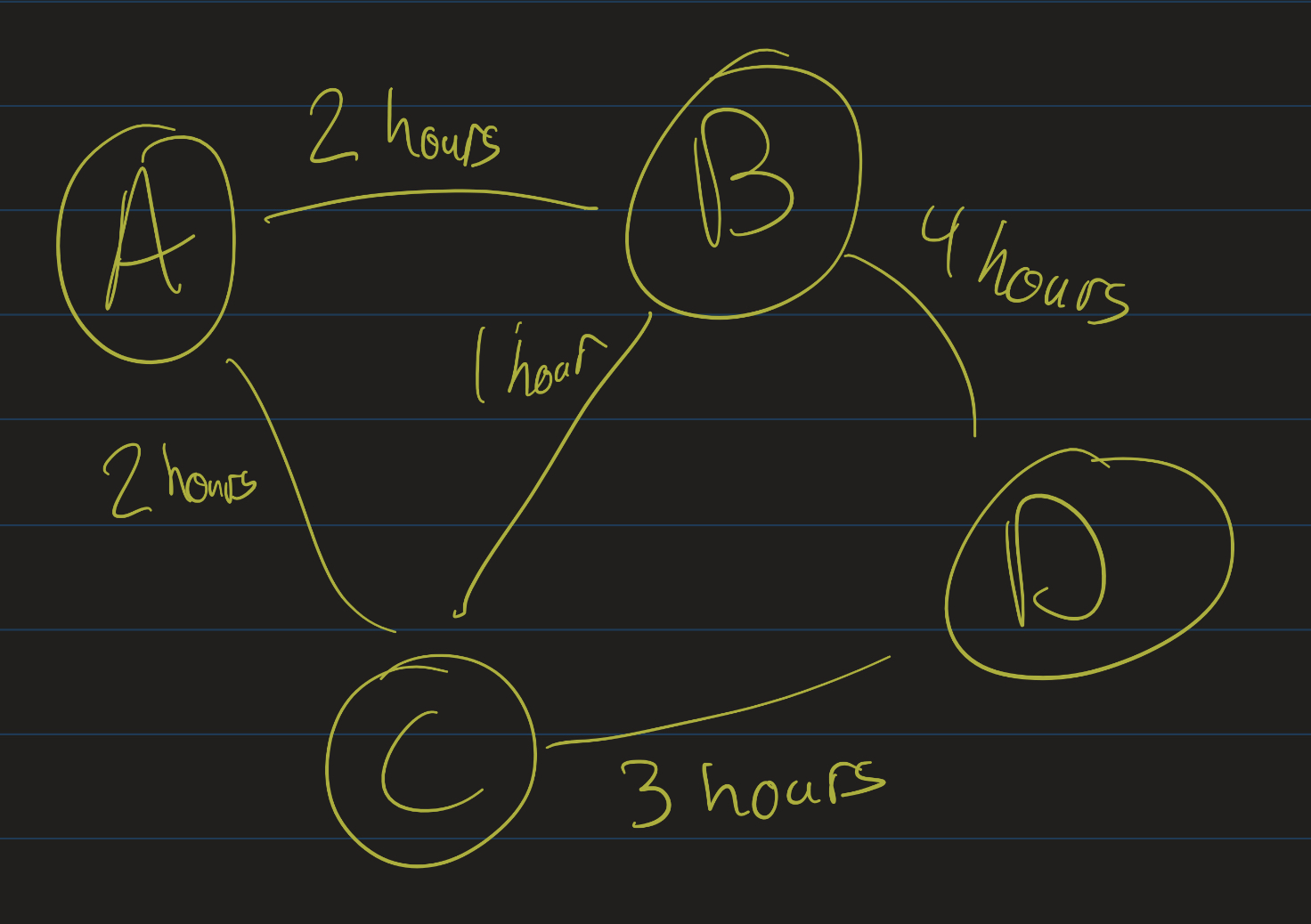
Given a graph $G = (V, E)$, the degree of a vertex $v$ is the number of edges connected to $v$.
- If an undirected $G$ contains self-loops, we count that as two edges connected to $v$.
- If $G$ is a directed graph, we can define the in-degree and out-degree of $v$:
- The in-degree of $v$ is the number of edges that point toward $v$.
- The out-degree of $v$ is the number of edges that start at $v$.
The degree-sequence of a graph $G$ is a sequence of all degrees in non-decreasing order. For example:

The degree sequence of this graph is $(1, 1, 2)$.
Exercises
At least one of the following problems is impossible! Can you figure out which one?
- Find an undirected graph whose degree sequence is $(1, 1, 2, 2)$.
- Find an undirected graph whose degree sequence is $(1, 1, 1, 2)$.
- Find an undirected graph whose degree sequence is $(2, 2, 2, 2)$.
- Find a simple undirected graph whose degree sequence is $(0, 1, 2, 3)$.
Check your answers
The second one is impossible! Take the vertex of degree 2. It is connected to two other vertices, each has degree one. Then there is no room for a third vertex of degree one to be placed anywhere: it must be connected to
The fourth one is also impossible. If our vertices have no self-loops, and one vertex has degree 3, it must be connected to three others. That would mean none of the vertices can have degree 0.
Graph 1: 
Graph 3: 
Some Quick Theorems
One of the benefits of formalizing graphs as vertices and edges is that the combinatorics of graph theory is sometimes quite simple. For example, in the previous exercise, we saw that it was not possible for a graph to have exactly three vertices of degree one and one vertex of degree 2. We can actually see a more general property using a counting argument.
Take any graph $G = (V, E)$. What can we say about the degrees of all the vertices? If we count vertices, it’s hard to say, but instead we can count edges. For each edge $e$, we see that it counts toward the degree of two vertices: each of its endpoints (or, if it’s a self-loop, by definition it counts twice toward the degree of one vertex). That means each edge is counted twice when we add up all the degrees. Which gives us the following result:
Theorem: The sum of the degrees of a graph is equal to twice the number of edges.
This is a fairly innocent theorem, but it has some important consequences. First of all, that means that the sum of the degrees is even.
Corollary: For any graph $G = (V, E)$, there is an even number of vertices of odd degree.
Proof: Since the sum of the degree is even, we can really think of this as a question of adding numbers mod 2. If we add an odd number of odd numbers, we get an odd number. Adding any even number after that would keep it as an odd number. Therefore, there must be an even number of odd numbers in that sum.
Eulerian Paths and Cycles
Before we tackle the Bridges of Königsberg problem, let’s make a few more definitions:
Definition: Let $G = (V, E)$ be an undirected graph.
-
A walk in $G$ is a sequence of vertices $v_1, v_2, \ldots, v_n$ such that, for each $i < n$, the vertices $v_i$ and $v_{i+1}$ are adjacent (connected by an edge).
-
A trail is a walk in which no edge is repeated.
-
An Eulerian path is a walk in which every edge is used exactly once.
-
An Eulerian circuit or an Eulerian tour is an Eulerian path that starts and ends at the same vertex.
We now have enough information to explain Euler’s proof that there is no solution to the Seven Bridges of Königsberg problem. Given a graph $G = (V, E)$, we ask: does this graph contain an Eulerian path? Does this graph contain an Eulerian circuit?
It turns out that these are questions that can be answered entirely by looking at the degree sequence of the graph. How would we use up all the edges at a particular vertex? Suppose that a vertex has degree 3. If we start at that vertex and take one of the edges, we have two more edges left to visit from that vertex. That means we have to return, which will will use one more edge, and leave it again, which will use the other edge. What if we didn’t start at that vertex? If we take an edge in, we take one out, and then we still have one edge left to use. That means that we would need to end at that vertex!
We can generalize this. If a vertex has odd degree, we would need to either start or end at that vertex. This is because, besides the beginning or end of the walk, every time we enter a vertex through one edge, we would leave through another. That means visiting a vertex in the “middle” of the walk would use up an even number of its edges. If a vertex has odd degree, then, it has to use one edge to leave at the beginning of the walk, or it has to use one edge to return at the end of the walk.
Theorem: A graph $G = (V, E)$ has an Eulerian path if and only if it has exactly two vertices of odd degree.
In particular, any Eulerian path would start at one of the vertices that has odd degree, and end at the other.
What about Eulerian circuits? If we are starting and ending at the same vertex, then every vertex must have even degree. Do you see why? If every vertex has even degree, then there is an Eulerian circuit starting and ending at any vertex.
Exercise: Determine if this graph has an Eulerian path and/or an Eulerian circuit. If so, find one.

Check your answer
Notice that the degree seqeunce of this graph is $(2, 2, 3, 3, 4)$. So this should have an Eulerian path!
One Eulerian path is: A - B - C - D - E - C - A - E.
Non-theorem: Hamiltonian Cycles
One of the amazing results in graph theory is that, while the Eulerian path problem has an easy solution involving just counting degrees, a related problem is not known to have any easy solution.
Definition: Let $G = (V, E)$. A Hamiltonian path is a walk in which every vertex in $V$ is visited exactly once. A Hamiltonian circuit is a walk starting and ending in the same vertex, in which every vertex other than the starting vertex is visited exactly once.
From the definition it appears to be quite similar to the Eulerian path / circuit problem, but this problem is NP-complete. There is no known “efficient” algorithm which determines if a graph with $n$ vertices has a Hamiltonian path or circuit whose running time is a polynomial function in $n$.
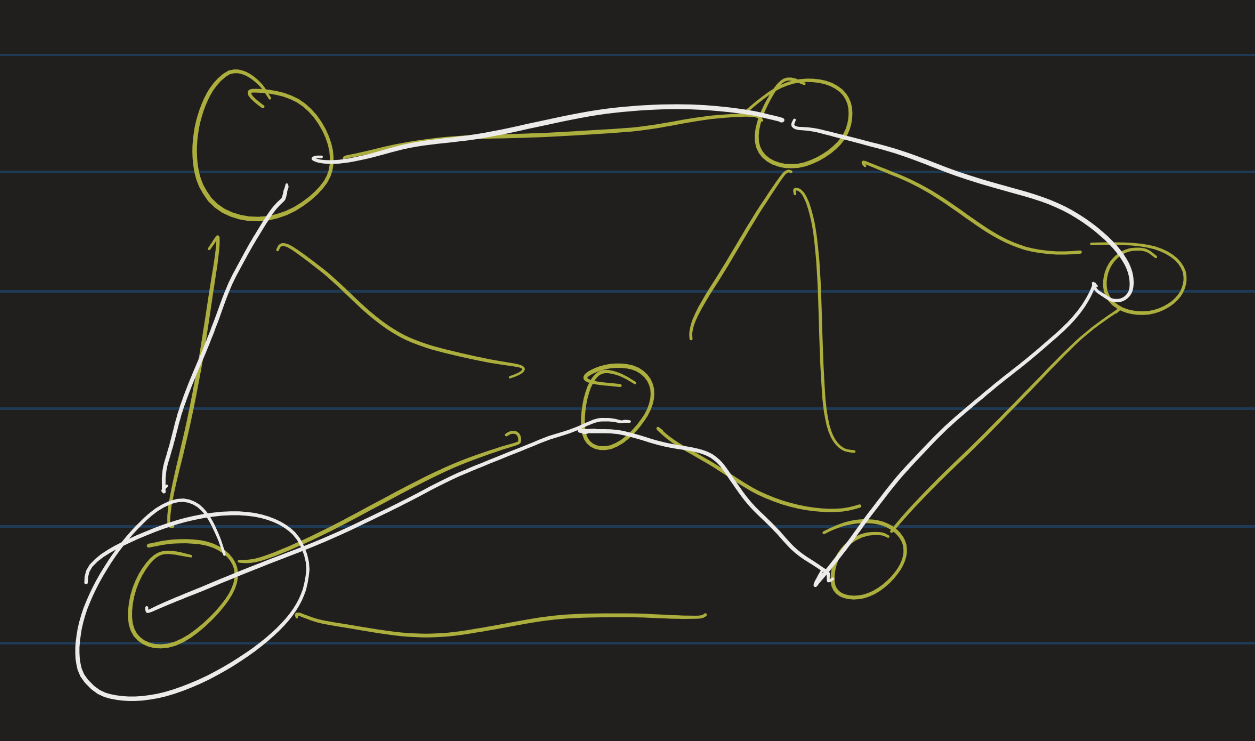
Special Kinds of Graphs
At this point, we should survey some examples of graphs so we have some language to describe kinds of graphs.
Complete Graphs
The complete graph on $n$ vertices is the graph obtained by putting edges between all pairs of vertices. Here are some examples.
$K_3$:

$K_4$:

$K_5$:

Counting edges, you can determine that $K_3$ has 3 edges, $K_4$ has 6, and $K_5$ has 10. Notice that to go from $K_n$ to $K_{n+1}$, you add in one vertex and connect it to all of the previous vertices. That is, $K_{n+1}$ has $n$ more edges than $K_n$ (so $K_4$ has 3 more than $K_3$, $K_5$ has 4 more than $K_4$, etc).
Exercise: Come up with a formula, in terms of $n$, for the number of edges in $K_n$. Prove that your formula is correct.
Note: This formula gives an upper bound for the number of edges in any simple undirected graph, since $K_n$ will have the most possible edges out of any $n$ vertex graph.
Cycle Graphs
A cycle graph on $n$ vertices is a simple, $n$-vertex cycle. That is, it has vertices $v_0, v_1, \ldots, v_{n-1}$, and edges between $v_0$ and $v_1$, $v_1$ and $v_2$, $\ldots$, $v_{n-2}$ and $v_{n-1}$, and $v_{n-1}$ and $v_0$.
Example: $C_6$:

Exercise: Draw $C_3, C_4, C_5, C_6$, and $C_7$. How many edges are in each of these graphs?
Bipartite Graphs
A bipartite graph is a graph in which the vertices are partitioned into two sets, $V_1$ and $V_2$, so that there are no edges between vertices in the same set in that partition. That is, if $x, y \in V_1$, then there is no edge between $x$ and $y$, and similarly, if $x, y \in V_2$, there is no edge between $x$ and $y$.
The complete bipartite graph $K_{n,m}$ is the bipartite graph where $|V_1| = n$, $|V_2| = m$, and every vertex in $V_1$ is adjacent to every vertex in $V_2$.
$K_{3,5}$:

Not every bipartite graph is one of these “complete” bipartite graphs. For example, let’s look at the cycle $C_6$ again:

This is bipartite! Starting at the top left and cycling around clockwise, number the vertices $v_0, v_1, v_2, v_3, v_4, v_5$. Then we can partition this into sets $V_1 = { v_0, v_2, v_4 }$ and $V_2 = { v_1, v_3, v_5 }$. Since it’s a cycle, each vertex $v_i$ is adjacent to $v_{i+1 \mathbf{ mod} 6}$ and $v_{i-1 \mathbf{ mod} 6}$. Checking each $i$, you can see that there are no edges between vertices in $V_1$ or between vertices in $V_2$.
This isn’t true for every cycle though. The cycle graph $C_3$ is not bipartite:

Numbering the vertices, starting at the top and going clockwise, as $v_0, v_1, v_2$, we see that if $v_0 \in V_1$, then $v_1$ and $v_2$ must be in $V_2$. But $v_1$ and $v_2$ are adjacent, so this does not work.
Question: Which cycle graphs are bipartite? Is $C_4$ bipartite? $C_5$? $C_7$? $C_8$?
Subgraphs
Given a graph $G = (V, E)$, a subgraph $H = (U, D)$ is a graph where $U \subseteq V$ and $D \subseteq E$. That is, a subgraph is formed from an original graph by possibly deleting some vertices and/or some edges (with the rule that if you delete a vertex, you must delete any edge connected to it).
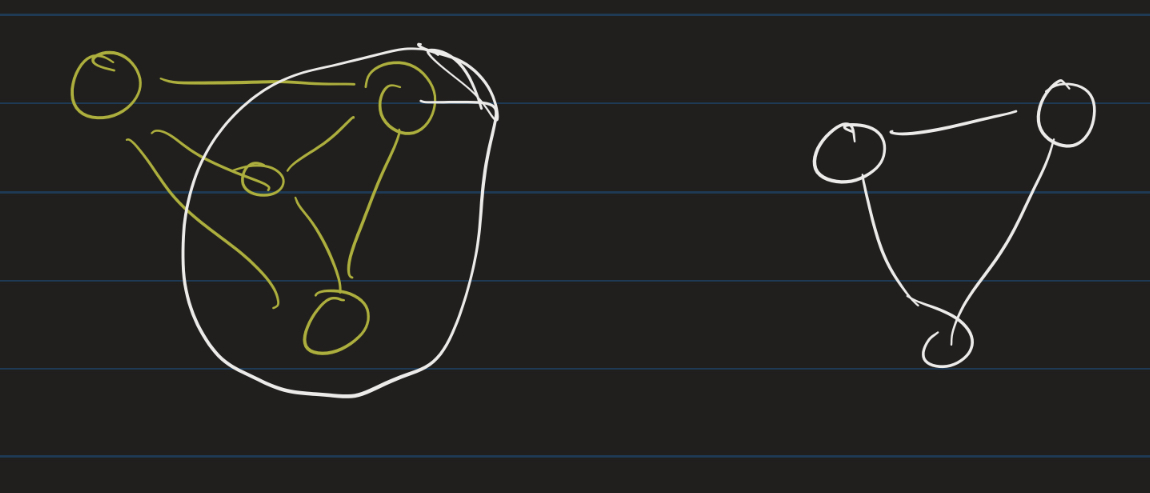
Further reading and exercises
- Graph Theory Intro from Discrete Mathematics: An Open Introduction.
- Graph Theory Definitions from Discrete Mathematics: An Open Introduction. Please pay attention to the glossary at the end of this section!
- Take a look at exercises 1-2, 6-8, 10(a,c), 12, 14, 16.
- Professor Gross’ Graph Theory Notes So far we have covered sections 10.1, 10.2, and parts of 10.4 and 10.5. Some of the terminology here is different from what we use in our notes / textbook.